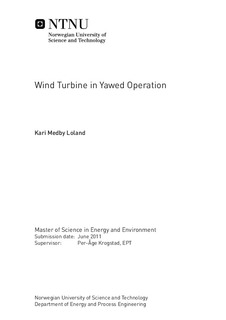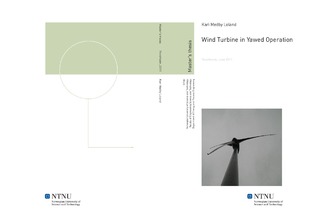| dc.description.abstract | The task of this project was to investigate the near wake, performance characteristics and yaw moment on a model wind turbine. The test turbine is a horizontal axis three bladed machine with a rotor diameter of 0.9 meter. Initially it is an upwind turbine, but was used for downwind measurements as well by rotating the blades and the entire construction 180^0. For the wake measurements the tip speed ratio was set to be TSR=3, TSR=6 and TSR=9 to describe the different regimes; partly stalled, optimal operation and partly propeller operation. Two different yaw angles, 0^0 and 30^0, was also explored for the near wake measurements. The velocity field was measured at X/D=1, as well as X/D=4 for TSR=6 and the two yaw angles; X/D being the number of rotor diameters downstream from the rotor plane. The performance characteristics and yaw moment were measured for yaw angles 0^0, 10^0, 20^0 and 30^0, and with tip speed ratios from 1 to 11. The power and thrust coefficients were found to decrease with increasing yaw angle. This is due to the reduced projected rotor area and reduced effective wind velocity component interacting with the turbine blades. The loss in power due to the yaw angle of the turbine is approximately 6% for yawAngle=10^0 and 40% for yawAngle=30^0 with upstream configuration. For downstream setup the reduction in power due to the yaw angle was 5.2% and 38% for yawAngle=10^0 and yawAngle=30^0 respectively. The near wake velocity field was strongly influenced by tip speed ratio and yaw angle. At TSR=3 the outer parts of the wake had a velocity close to the freestream velocity. Therefore much of the flow passes through without interacting with the rotor blades. For TSR=6 the velocity deficit was close to uniform in the wake. Most of the turbine blades operate efficiently at the design condition, and gives the peak in the power coefficient curve at this TSR. When TSR=9 the inner part of the blades experience negative angle of attack and provide energy to the wind instead of subtracting it. The outer parts of the blade operate more efficiently, but due to the inner part working as a propeller the power coefficient is low. The thrust coefficient is high for this operating condition. When the turbine is operating in yawed condition, the wake width is reduced and shifted towards the yawed direction. At downstream distance X/D=4 for TSR=6 the wake deficit becomes more uniform for both yawAngle=0^0 and yawAngle=30^0. For the downstream configuration the yaw moment was generally stable at more operating conditions than the upstream setup. Common for both configurations was that the yaw moment tended to rotate the rotor plane out of the wind at low tip speed ratios and yaw angles. The downwind turbine got a stabilizing moment for a lower tip speed ratio than the upwind turbine for all yaw angles. Both upwind and downwind turbine setup had an unconditionally stable yaw moment for yawAngle=30^0. | nb_NO |

